November 12-13 2015 the Native American Culinary Association and Tohono O’odham Community Action hosted the Celebration of Basketry and Native Food Symposium at the Arizona Sonora Desert Museum in Tucson AZ. This event brought together Native chefs, food producers, basket makers, students and scholars to discuss how to best promote healthy indigenous foods in Native communities.

Chef Nephi Craig, hard at work in the kitchen in between coordinating panels at the conference. In the opening keynote, Nephi highlighted the importance of people coming together from across the country to discuss and learn more about Indigenous foods. He described participants as pebbles in a pond– each would cause a ripple when they returned home, and congratulated them on taking part in this movement; “the beauty and poetry of Native foods fight now requires a sense of courage and discipline in researching your food ways.” Nephi also described the importance of cuisine in social recovery for Native peoples, and of edible education; “knife skills are life skills.” In addition, Nephi described the “power in each humble little seed of corn, or amaranth, or acorn,” and the importance of “re-membering” these foods, “making them part of our families again.” You can follow his work on his “Apaches in the Kitchen” blog. Photo by Elizabeth Hoover.

Many of the presentations were accompanied by samples. Chef Nephi Craig gave everyone a sample of “Apache Trail Mix,” which included a variety of nuts and seeds, including sunflower seeds, pinons,pepitas, and cranberries. Photo by Elizabeth Hoover
One of the first presentations of the conference was delivered by Twila Cassadore, from the Western Apache Diet Project. Twila has been working with San Carlos Apache, White Mountain Apache, and Yavapi peoples for the past 25 years, conducting interviews with elders to bring information back into the community to address health and social problems. Twila described the importance of foods like grass seeds and acorn seeds to the diets of Apaches before people were moved onto reservations and became reliant on rations, and later, commodities. She highlighted, “it took a community to do this. Not individual, not going to the grocery store and buying a bag of flour. You had to wait for the season for Mother Earth to offer to you.” Twila passed out a sample of milled acorn flour, which was sweet and nutty and delicious. In our sample cup we also each received a whole acorn. She instructed us to take out that acorn and roll it around in our hands. Several exclamations of ‘ouch!’ came from the audience as we felt the sharp end of the acorn poke our palms. “see, it’s sharp and it pokes you. This is how people apply programs to us.” She then instructed us to lay the acorn on its side and roll it back and forth in our palms, with just the smooth edge rolling against our skin. “This is how Native thinking works. This is how programs should be run.”
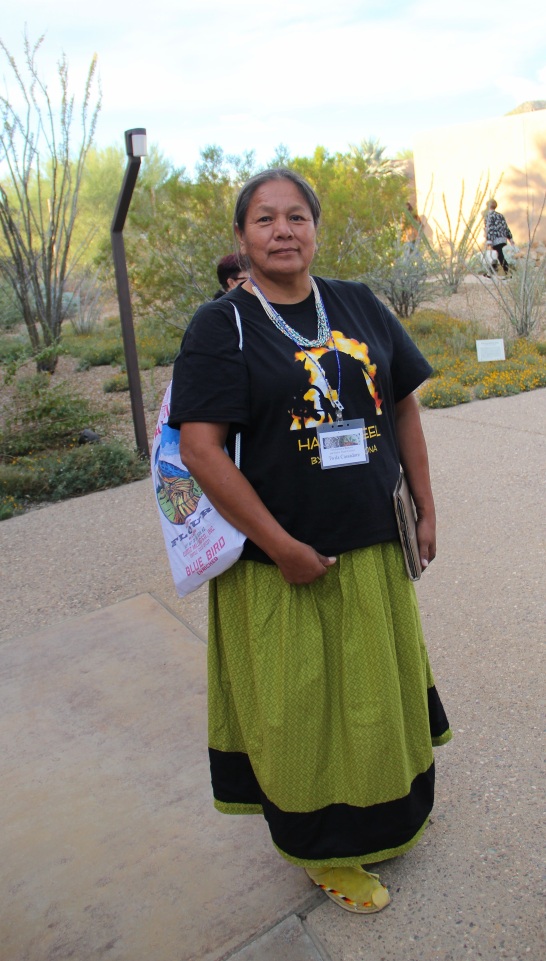
Sean Sherman presented about the importance of learning about local foods as well as ancestral cooking techniques.Sean’s business, The Sioux Chef, is based on creating cuisine solely from ingredients that were available in the Great Lakes and Northern Plains region prior to contact with Europeans. Sean’s presentation highlighted the importance of ethnobotany– being able to identify and eat local plants, and getting to know your land and the region that you’re focused on. He also highlighted the importance of learning more about ancestral cooking techniques– understanding how to cook with fire, stones, and the sun, methods that kept people alive for eons. Lakota people would roast food over a fire, heat stones to place in soups and use the sun, wind and fire to dry and preserve foods. Meats, flowers, roots like timpsala (prairie turnips) and greens were put away for a whole season.

Chef Andrea Murdoch celebrates her Inca ancestry through one of her favorite vegetables– purple potatoes (with which Chef Loretta is clearly awestruck). Photo by Elizabeth Hoover

Andrea’s presentation was followed by a sample of purple potato gnocchi made with quinoa flour, maple sumac squash puree, and maple candied squash seeds. Andrea’s cuisine represents her Incan roots from her ancestral Venezuala, as well as the Polish roots of her adopted family, and the produce of her home in Wisconsin. (Photo by Elizabeth Hoover)

Claudia Serrato is a P’urhepecha chef from California, who is also currently working on a Phd in Anthropology through the University of Washington. Her dissertation focuses on the transmission of ancestral memories through Indigenous foods, and the various healing modalities of Indigenous ethnogastronomies. You check our her “Decolonial Food For Thought” blog and her alterNative Anthropology Tumbler. Here, Claudia was kind enough to help me with my demonstration sample of wild rice. (Photo by Elizabeth Hoover)

Chef Karlos Baca (Dine/Tewa) is the founder of The Taste of Native Cuisine, an enterprise that aims to bring together Native American chefs and cooks to provide traditional wild harvested and hunted foods to tribes in the Four Corners region. He is also the executive chef at the Dunton Hot Springs resort. Here Karlos is preparing a blue corn cake. Photo by Elizabeth Hoover

So many Native chefs in one kitchen! Half of the fun of the conference for me was to witness all of the behind the scenes chopping, stirring, cooking, tasting, consulting, sharing, and laughing that went on when you have this many Native chefs together in one space. Photo by Elizabeth Hoover

Chris Rodriguez slicing jalapenos. Chris is a Xicano professional chef and co-creator of the grassroots community health project Decolonial Food For Thought. He is an independent scholar and political commentator on native and Indigenous food autonomy and sovereignty movements in Mesoamerica. Photo by Elizabeth Hoover.

Loretta Barrett Oden (Potawatomi), preparing to make a quinoa salad. For those of you unfamiliar with the Native chef world, during this conference Loretta was alternatively referred to as “the godmother of Native cooking” by one young chef, and as “the OG who made it possible for us to all be here” by another. Photo by Elizabeth Hoover.

Chef Neftali Duran making tortillas for lunch. Neftali was born in the Mexican state of Oaxaca to a Mixteco family of “cooks, healers, and campesinos.” When he was 17 he began cooking in Los Angeles, before moving to Western MA and opening a bakery. In addition to directing food justice programs at Nuestras Raices in Holyoke MA, Neftali travels around the country hosting pop-up dinners featuring Oaxacan cuisine, and educating audiences about the history of indigenous foods of Mexico, and the ever-evolving cuisine of his home region. Behind him is Navajo chef Frankie Peralta. Photo by Elizabeth Hoover

Chef Neftali, working with Chris and JD from Navajo Technical College on a salsa (that’s a giant immersion blender, not a boat motor…). Photo by Elizabeth Hoover

Chef Neftali with Chris, a student from Navajo Technical College, preparing guajillo chili peppers for the churro tacos (Photo by Elizabeth Hoover)

Lunch break! Chefs Franco Lee and Neftali Duran setting up tacos and pozole. Photo by Elizabeth Hoover

Blue corn cake with sumac. Photo by Elizabeth Hoover

Chef Nephi Craig mentoring a student from Navajo Tech. A note from the chef on the tempura carrots balanced on the driftwood in front of them: “Pictured here are my Dineh Blue Corn ‘Tempura’ Chefs Garden Carrots drizzled with Agave Chili Glaze, served over fresh corn husks in a large driftwood from the Salt River Canyon. I simply washed the carrots and roasted them skin on until tender, split the larger carrots, and prepared a batter with blue corn meal seasoned with honey and chili flakes, and then dipped the carrots and fried them crisp, finished with the agave chili glaze, it was amazing. In the basket are roasted jalapenos and serrano chilis.” Photo by Elizabeth Hoover.

Roasted winter squash with corn, carrots, and tepary beans. Photo by Elizabeth Hoover

Sean Sherman, The Sioux Chef, with Dana Thompson, getting ready to dish out soup; blueberry broth over dried buffalo meat, sunflower sprouts, a seed mixture, and flower petals . Photo by Elizabeth Hoover
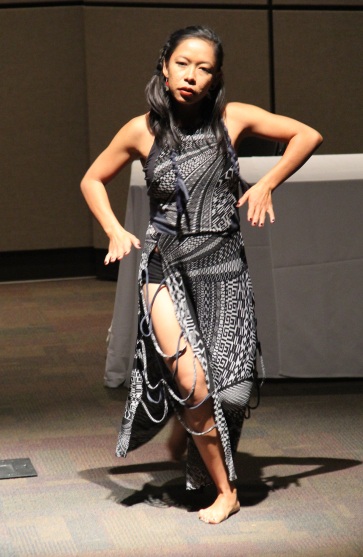
Anne Pesata, an Apache woman who is a dancer as well as a basket maker, and did an amazing contemporary dance about how her experience as a 5th generation basketmaker, learning these skills from her mother and grandmother. Photo by Elizabeth Hoover

Paleo-ethnobotanist Fred Wiseman presenting about the Seeds of Renewal Project, an intertribal effort to restore Wabanaki agriculture as a fully integrated food system to the various federally and state recognized tribes in the Far Northeast. Photo by Elizabeth Hoover

Dr. Lois Ellen Frank (Kiowa) signing copies of her book “Foods of the Southwest Indian Nations,” which won the James Beard Award in the Americana category and was the first Native American book to win the award. Photo by Elizabeth Hoover

Sterling Johnson (Tohono O’odham) from the Ajo Center for Sustainable Agriculture, collaborated with Nina Sajovec to present about heirloom pomegranate varieties (photo by Elizabeth Hoover)
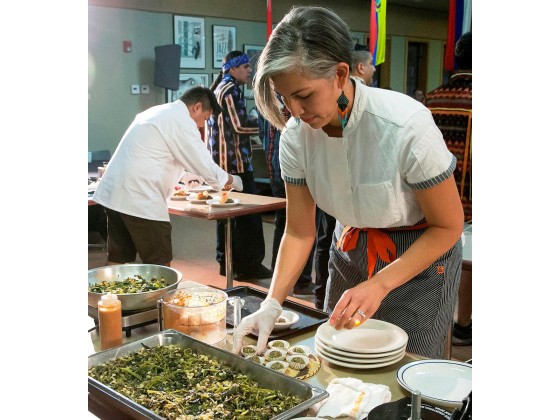
Felicia Cocotzin Ruiz (Xicana/Tiwa) described her career as a chef, as well as the workshops and classes that she hosts that promote wellness and healthful eating. Photo courtesy of Idyllwild, where Felicia took part in an Indigenous chef competition
Friday evening of the conference included a special dinner showcasing the talents of many of the chefs participating in the conference. The menu included an array of delicious appetizers like caviar; spicy Houma shrimp with jicama slaw and avocado creme; three sisters fritters; and blue corn tamales with rabbit meat. The main dinner included a nopal cactus pad salad with roasted bell peppers and orange segments, and a fiery jalapeno vinagrette; a hominy harvest stew featuring red, white and blue hominy corn pozole, zucchini, yelllow squash, heirloom tomatoes, New Mexico red chile, and azafran; seared Achiote Duck Breast with wild rice and quinoa pilaf with sauteed cholla buds; coriander cured elk tenderloin; and a desert of Western Apache Seed mix fritter, honey braised butternut squash , pinon cloud, citrus marigold blossoms, chocolate and amaranth.

Chef Terri Ami (Navajo/Hopi) plating the nopal, orange, bell pepper and micro green salad. Photo by Elizabeth Hoover

Sous chef Lorencinta Billiman (Navajo) working hard to make sure all of the thorns are removed from the cholla buds (photo by Elizabeth Hoover).

Beautiful tables, with a fabulous desert! Desert by Nephi Craig (this photo doesn’t do it justice!). Western Apache Seed mix fritter, honey braised butternut squash , pinon cloud, citrus marigold blossoms, chocolate and amaranth. Photo by Elizabeth Hoover

Crew of chefs at the end of the night. Photo by Elizabeth Hoover
The conference continued on Saturday, when the program became open to the public,and include cooking demonstrations around the museum property
Chef Loretta Barrett Oden described some of her favorite dishes from her Corn Dance restaurant, formerly located in Santa Fe, especially those that incorporate sweet corn. Even after the corn is eaten, you can boil the cobs into a sweet broth, which can then be made into various soups and deserts. Loretta encouraged the audience to source local ingredients, and then gave a quick lesson on how to make “Three Sisters and Friends” salad.

One of the outside demonstrations was Ruby Chimerica (Hopi) making paper-thin piki bread from blue corn batter.
Ed Mata (Yurok) brought fresh salmon from northern California, and roasted it over a fire outdoor for everyone to try
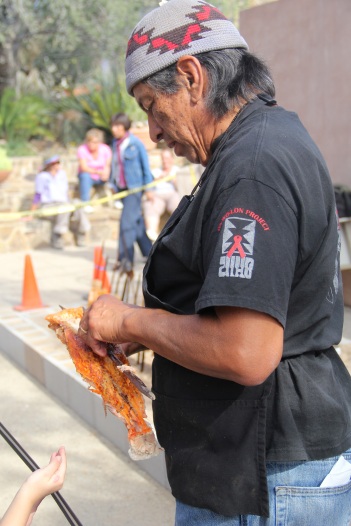
Ed Mata, offering roasted salmon to a little hungry outstretched hand. Photo by Elizabeth Hoover




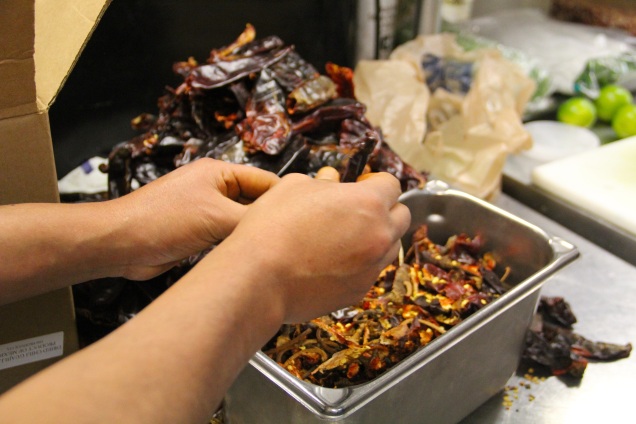








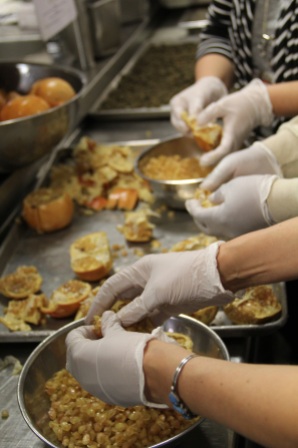







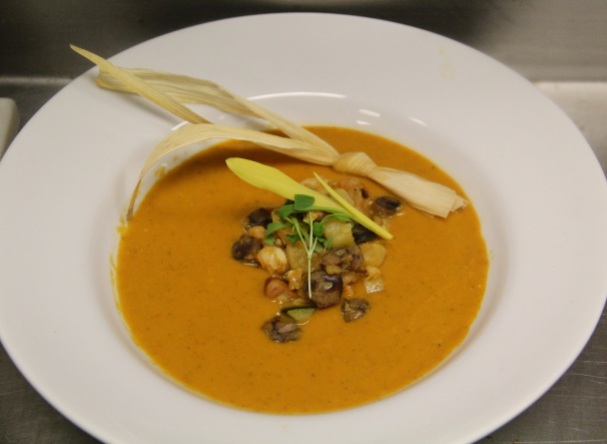



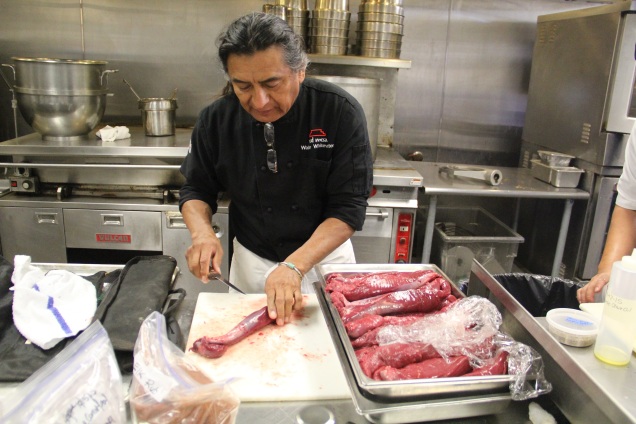










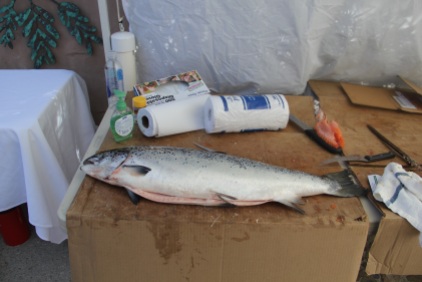

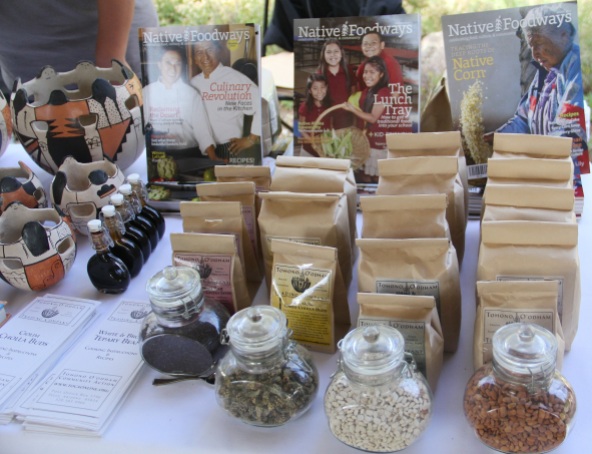




I’m in Utah, a good scientist and nutritionist
How can I help? I can generate Nutritional Facts Labels and such. I can teach sensory evaluation/ taste paneling.
Thanks